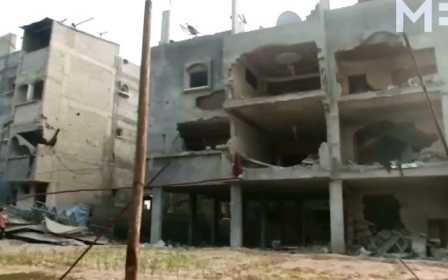Unexploded ordnance kills 4 as Gaza war continues to sow death and destruction

RAFAH, Gaza Strip – It’s been almost a year since the guns fell silent following the bloody 50-day conflict with Israel that rocked Gaza, but the war is still claiming lives.
On Wednesday morning ambulance sirens were once again bellowing through the streets as they made their way to Abu Yousef al-Najjar hospital in Rafah.
As they howled they woke everyone up. The residents and patients alike stirred and began to worry about what had happened overnight.
Soon, the horror of the night emerged as the ambulance workers brought out bodies of children and elderly - all victims of an unexploded Israeli ordnance left over from last summer’s war.
So far Gaza’s health authorities have confirmed that four people – all members of the Abu Nukira family - have been killed. At least 35 others were injured, including four who were in critical condition, the authorities added.
Journalism professor Ayman Abu Nukira lost three relatives in the explosion. Despite being badly injured he insisted on being carried on a stretcher to his son’s funeral late on Thursday afternoon.
Dr Ashraf al-Qidra, spokesman of Gaza Health Ministry, said the ordnance exploded as Palestinian workers tried to help family members remove rubble from a house destroyed in the war.
Last summer the people of Rafah experienced one of the most aggressive attacks by Israel, remembered now as Black Friday. During the three-day escalation that broke out after the abduction of an Israeli soldier, the area was hit hard by Israeli tank shells, bombs and air-to-ground missiles.
According to a report by Amnesty International and Forensic Architecture released last week, more than 135 Palestinian civilians – including 75 children – were killed during the period in an episode that could amount to Israeli war crimes and crimes against humanity.
While Rafah residents have been trying to put their lives back together, they now say they feel like they are being forced to relive that nightmare all over again.
Ghassan Saleh, 21, who helped ambulance crews collect the remains of bodies at the blast site, told Middle East Eye that the reality of having to attend fresh mass funerals had awakened painful memories.
While the wounds feel new, this is not the first death from an unexploded warhead in Gaza. Over the years, there have been many deaths.
Since last year’s war, six people - including an AP journalist and his Palestinian translator- were killed. Another three have been injured during planned media coverage on how Palestinian police defuse unexploded Israeli ordnance.
Unexploded munitions
Ahmed Abu Dayya, director of office for Explosives Engineering in Gaza told MEE, "Occupation fighter jets dropped thousands of tonnes of missiles and explosives, some of which did not explode, causing a threat to the life of people."
As long as the rubble remains, so will the fear that further incidents like this could happen.
“We survived the war, but one fears that we could die any moment by whatever unexploded missiles are under the ruins of demolished homes,” said 41-year-old Ayman Abu Lebda, a Rafah resident.
According to a report by Handicap International, conducted after the war but published last month, half of Gaza’s 1.8 million people express daily fear and anxiety about unexploded bombs - fear that is fuelled by the knowledge that the ordnance could be anywhere, from offices and shops to schools and hospitals.
Rubble has been removed from several parts of Gaza Strip by UNDP under Swedish funding. However, there are still hundreds of homes in the southern part of the Gaza Strip that need to be cleared and declared safe.
"Reconstruction work in Gaza can only begin once the rubble has been removed," Guillaume Zerr, Handicap International’s head of mission in the Palestinian Territories said in the report.
"This phase is very high risk, given the large amounts of unexploded ordnance in the rubble. The local population is highly exposed, as they often undertake the removal work themselves."
Local police engineers in charge of defusing missile remains have also become victims of their work and several have been killed since last year.
Stay informed with MEE's newsletters
Sign up to get the latest alerts, insights and analysis, starting with Turkey Unpacked
Middle East Eye delivers independent and unrivalled coverage and analysis of the Middle East, North Africa and beyond. To learn more about republishing this content and the associated fees, please fill out this form. More about MEE can be found here.






